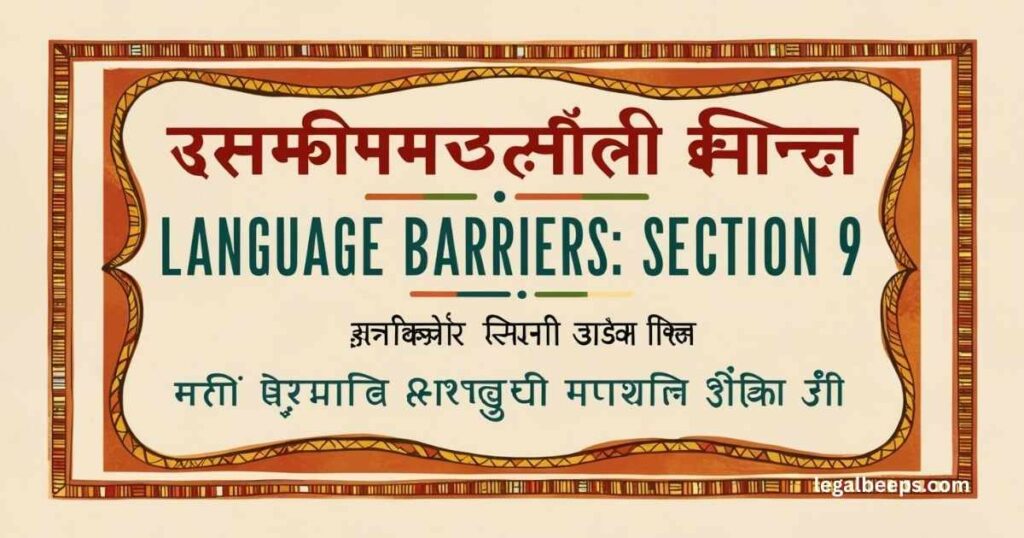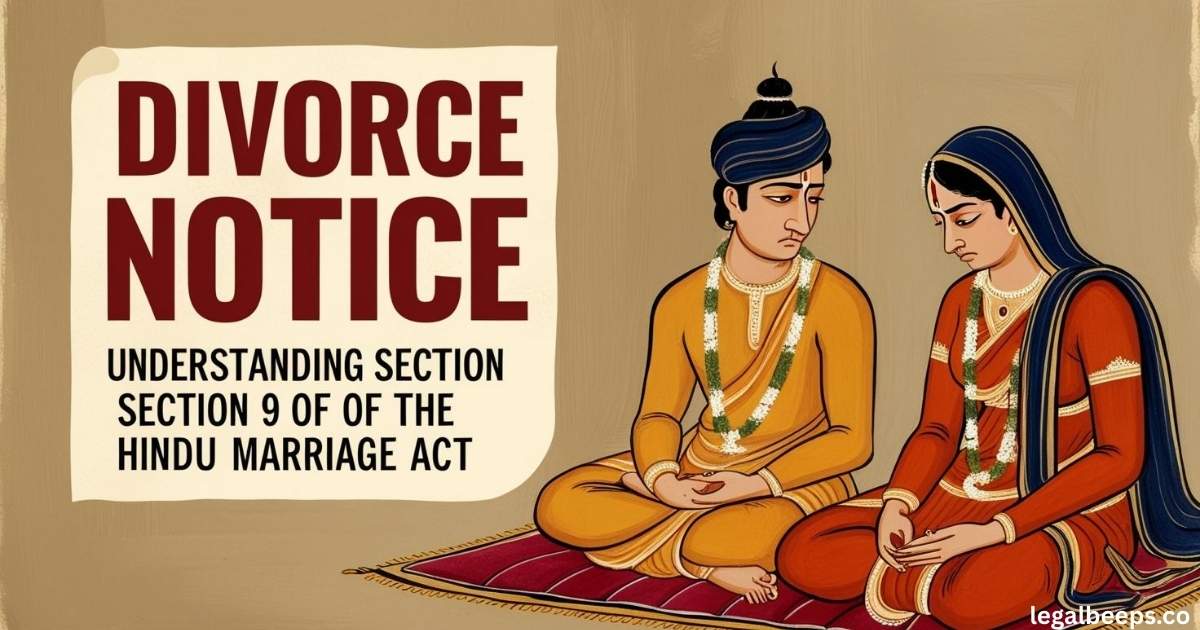Getting a divorce notice can turn your world upside down. It’s not just a piece of paper,it’s the first legal signal that your marriage may be ending. A divorce notice tells your spouse you want out, and if ignored, it can lead to court battles. Sadly, many don’t fully understand what a divorce notice means. In India, laws like 115 2 BNS in Hindi, 506 dhara kya hai, and 406 IPC in Hindi often come into play.
These laws deal with property, threats, and cheating in marriage. If there’s violence or abuse, 352 BNS in Hindi and 323 dhara kya hai may apply. A divorce notice is serious. It’s emotional. It’s legal. It’s life-changing. Whether you’re sending or receiving one, know your rights. Talk to a lawyer. A divorce notice might be painful,but sometimes, it’s the beginning of peace
What is Section 9 of the Hindu Marriage Act?
Section 9 of the Hindu Marriage Act talks about the restitution of conjugal rights. It means if one spouse leaves without reason, the other can send a notice or ask the court to help. The court may order the partner to return. A notice may follow if this fails.
Filing for Restitution of Conjugal Rights (Dhara 9)
Filing for restitution of conjugal rights, also called Dhara 9, happens when one spouse leaves the other without reason. The affected partner can file a case in family court. Before that, they may send a divorce notice. A notice is often the first warning before going to court.
Once the case is filed under Dhara 9, the court may ask the partner to return and live together again. If they don’t agree, it may lead to legal steps like a divorce petition. A notice may turn into court action. This process protects marital cohabitation rights and helps decide next steps.
Legal Process for Restitution
- Starting the process: One spouse can begin the case by filing a petition under Section 9 of the Hindu Marriage Act in the family court.
- Sending a divorce notice: Before filing, the spouse may send a notice to inform the other partner of the issue.
- Court summons: After filing, the court issues a legal notice asking the other spouse to attend the hearing.
- Responsibility to prove: The person who filed must prove that the partner left the home without a valid reason.
- Court decision: If the court agrees with the claim, it may order the spouse to return and live together again.
- Next legal steps: If the spouse refuses, the petitioner can proceed with a notice or a divorce petition for separation.
- When the spouse expresses no intention of returning to the marriage.
- If the marriage has broken down beyond repair despite several attempts to reconcile.
- When one spouse is unwilling to attend counseling or therapy sessions.
- If a partner continuously violates marital rights, creating a toxic environment.
The Role of Divorce Notice in Section 9 Cases

In Section 9 cases, a notice plays an important role. Before going to court, the spouse may send a notice to the other, informing them of their intent to seek restitution. If the partner refuses to comply, the notice can lead to further legal action in family court.
Divorce Notice and Section 9: Key Differences
A notice is the formal way to inform a spouse about the intention to end a marriage. It is sent when one partner seeks a legal separation. On the other hand, Section 9 of the Hindu Marriage Act deals with the restitution of conjugal rights, not divorce.
The main difference is the goal. A divorce notice aims to terminate the marriage, while Section 9 seeks to bring the couple back together. If the spouse refuses to reconcile, a notice may follow. Section 9 is about restoring marital cohabitation, whereas a notice initiates the end of the relationship.
When to Send a Divorce Notice?
- When marriage breakdown is clear: If both spouses agree that the relationship cannot be repaired, sending a notice may be necessary.
- After failed reconciliation: If attempts to fix the marriage, including Section 9 petitions, don’t work, a notice can be the next step.
- When one spouse refuses to return: If a spouse refuses to follow the court’s order under Section 9, sending a notice becomes essential.
- When emotional and legal complexities arise: If there’s emotional distress and no way forward, a notice might be needed to end the situation.
- After long-term separation: If the couple has lived apart for a long time, and efforts to reunite fail, a notice may be served.
- To start legal proceedings: A notice is often the first official step toward beginning legal divorce proceedings.
Understanding Restitution of Conjugal Rights (Sec 9)
Restitution of Conjugal Rights (Section 9) allows one spouse to request the other to return and resume the marital relationship. If a partner leaves without valid reason, the other can send a notice or file a petition in court. This section helps restore marital cohabitation before divorce proceedings.
Impact of Section 9 on Divorce Proceedings
- Evidence in divorce case: If a spouse doesn’t comply with Section 9, it can be used as proof in a divorce petition later.
- Possible grounds for divorce: Refusing to return after the court’s order can be seen as desertion, which is a valid ground for divorce in India.
- Strengthening the petition: If the spouse fails to return, it strengthens the case for divorce. A notice may follow.
- Legal impact: Section 9 actions show the court that reconciliation efforts were made before seeking divorce.
- Delaying divorce: If Section 9 is used, the divorce process may take longer due to attempts at reconciliation.
- Alternative solutions: Section 9 may offer a chance to restore the marriage before moving forward with a divorce notice.
Language Barriers: Section 9 in Hindi, Marathi, and Other Languages

For people who are not comfortable with English, legal terms can be confusing. That’s why it’s important to explain laws like Section 9 in local languages. Translating legal ideas into Hindi, Marathi, and other Indian languages helps people better understand things like Divorce Notice and their marital rights.
- Section 9 in Hindi: Often called Dhara 9 kya hai, this explains the right to ask a spouse to return to the marriage.
- Restitution of conjugal rights in Marathi: Translations like this help people understand how the law supports couples.
- Clear meaning of Divorce Notice: Knowing what a Notice means in one’s native language helps avoid confusion.
- Legal awareness grows: Regional translations raise awareness and make the legal process easier to follow.
- Better access to justice: When laws are explained in local languages, more people can defend their rights.
- Helpful for court cases: Understanding terms like Section 9, Divorce Notice, and legal steps improves participation in court cases.
Read Also: 506 IPC in Hindi: आपराधिक धमकी के लिए सजा और प्रावधान
Divorce Notice Sent to Wife
A Divorce Notice sent to the wife is a formal way to inform her about the husband’s decision to end the marriage. It includes reasons for separation and asks for her response. A Notice gives both time to think, seek legal help, or move forward with divorce proceedings.
Divorce After Section 9 Petition
If a Section 9 petition fails and the spouse refuses to return, a Notice may follow. This shows that all efforts for reunion were made. When reconciliation doesn’t work, the next legal step is often separation. A Notice helps begin the process of ending the marriage legally.
Courts may view a denied Section 9 order as proof of marriage breakdown. It becomes easier to prove desertion or lack of cohabitation. A Notice after such failure highlights serious emotional and legal issues. It signals the end of hope for reunion and starts the divorce journey.
How to Draft a Divorce Notice?
Writing a Notice the right way is important. It should clearly explain why one spouse wants to end the marriage. The notice must be respectful and follow the law. Here’s what to include when drafting a proper Divorce Notice:
- Reason for divorce: Clearly mention why the marriage cannot continue, such as desertion or emotional cruelty.
- Reference to past efforts: Include details about any Section 9 petitions or failed reconciliation attempts.
- Legal background: Mention any legal actions taken, like a court order or Restitution of Conjugal Rights claim.
- Call for response: Ask the other spouse to reply within a certain time. This keeps things fair.
- Lawyer’s details: Add the contact information of the lawyer handling the case.
- Calm and clear tone: Make sure the Notice is polite, legal, and not threatening in any way.
Other Legal Provisions: Section 9 IPC and CrPC
| Provision | Applicable Law | Purpose | Key Difference |
| Section 9 Hindu Marriage Act | Hindu Marriage Act | Restitution of conjugal rights | Focuses on reuniting married couples legally through court intervention. |
| Section 9 IPC | Indian Penal Code (IPC) | Deals with definitions and general clauses | It’s not related to marriage, but outlines general principles of criminal liability. |
| Section 9 CrPC | Code of Criminal Procedure | Jurisdiction of criminal courts | Specifies which court has authority in criminal trials and proceedings. |
| Section 406 IPC | Indian Penal Code (IPC) | Criminal breach of trust | Often used in marital disputes involving dowry or property. |
| Section 506 IPC | Indian Penal Code (IPC) | Criminal intimidation | Applied when one spouse threatens the other during or after a Divorce Notice. |
| Section 115(2) BNS | Bharatiya Nyaya Sanhita | Describes penalties for false evidence | Newly introduced in BNS, relevant when false claims are made in Divorce Notice cases. |
FAQ’s
What is Section 9 of the Hindu Marriage Act?
Section 9 of the Hindu Marriage Act deals with Restitution of Conjugal Rights. It helps a spouse file a Notice if the other refuses to resume cohabitation.
How does Section 9 impact a Divorce Notice?
When a spouse does not comply with a Notice after Section 9, it can lead to the grounds for divorce. The Divorce Notice will indicate failed reconciliation attempts.
Can Section 9 help avoid a Divorce Notice?
Section 9 aims to restore marital cohabitation. If successful, it can prevent the need for a Divorce Notice. It provides a chance for reconciliation before filing for divorce.
What happens if a spouse ignores a Divorce Notice under Section 9?
If a spouse ignores the Notice or refuses to comply with Section 9, it can strengthen the case for divorce. This non-compliance acts as evidence in the legal process.
Is a Divorce Notice mandatory after a Section 9 petition?
After a Section 9 petition, if the spouse refuses to return, sending a Notice becomes necessary. It officially begins the legal process to end the marriage.
Conclusion
A Divorce Notice is a formal document that starts the process of ending a marriage. It informs the other spouse of the intention to separate. This notice is an essential legal step before filing a divorce petition in court. A Divorce Notice must clearly state the grounds for divorce and request a response from the recipient.Receiving a Notice can be emotional, but it’s important to handle it carefully. You must respond within the time mentioned in the notice.
If the recipient ignores the Divorce Notice, it can lead to legal consequences. Understanding the contents of the Notice is crucial, as it can affect the next steps in the divorce process. Always seek legal advice to understand your rights. A well-drafted Notice can protect both parties and ensure that the divorce process follows the law.

